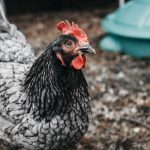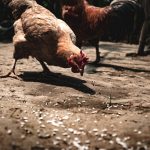Molting is a natural process in which chickens shed and regrow their feathers. This typically occurs once a year, usually in the fall, and can last for several weeks. During this time, chickens may appear scruffy and may stop laying eggs as their bodies redirect energy towards feather regrowth.
Understanding the molting process is crucial for chicken owners to provide the necessary care and support for their flock during this time. It’s important to recognize that molting is a normal and necessary part of a chicken’s life cycle, and it’s essential to provide them with the proper environment and nutrition to help them through this process. Molting is a complex biological process that requires a significant amount of energy and nutrients.
Feathers are made up of protein, so chickens need a high-protein diet to support the growth of new feathers. Additionally, molting can be a stressful time for chickens, so it’s important to provide them with a comfortable and secure environment to minimize any additional stress. Understanding the signs of molting, such as decreased egg production and changes in feather appearance, can help chicken owners provide the necessary care and support for their flock during this time.
By understanding the molting process, chicken owners can ensure that their flock remains healthy and comfortable throughout this natural biological process.
Table of Contents
- 1 Providing adequate shelter and bedding for molting chickens
- 2 Supplementing molting chickens’ diet with high-protein treats
- 3 Ensuring proper ventilation and air circulation in the coop
- 4 Using heating lamps or other heat sources for molting chickens
- 5 Monitoring the temperature and humidity levels in the coop
- 6 Consulting a veterinarian for additional advice and support for molting chickens
- 7 FAQs
Key Takeaways
- Molting is a natural process in chickens where they shed old feathers and grow new ones
- Providing a warm, dry, and comfortable shelter with ample bedding is crucial for molting chickens
- Supplementing the diet with high-protein treats like mealworms can support feather regrowth during molting
- Proper ventilation and air circulation in the coop are essential to prevent respiratory issues during molting
- Using heating lamps or other heat sources can help molting chickens stay warm, especially in colder climates
- Regularly monitoring temperature and humidity levels in the coop is important for the health of molting chickens
- Consulting a veterinarian can provide additional advice and support for the care of molting chickens
Providing adequate shelter and bedding for molting chickens
Creating a Comfortable Environment
A clean and dry coop with plenty of bedding, such as straw or wood shavings, can provide a soft and supportive surface for molting chickens to rest and move around without causing additional stress or discomfort.
Maintaining a Stable Environment
Additionally, ensuring that the coop is free from drafts and leaks can help maintain a stable and comfortable environment for molting chickens. In addition to providing adequate bedding, it’s important to ensure that the coop is well-ventilated to prevent moisture buildup and maintain air quality. Proper ventilation can help regulate temperature and humidity levels, which is essential for supporting the molting process.
Regular Maintenance and Repairs
Chicken owners should regularly inspect the coop for any signs of damage or wear and tear, such as holes in the roof or walls, and make any necessary repairs to ensure that the coop provides a safe and comfortable environment for molting chickens. By providing adequate shelter and bedding, chicken owners can help minimize stress and discomfort for their flock during the molting process.
Supplementing molting chickens’ diet with high-protein treats

Feathers are made up of protein, so molting chickens require a high-protein diet to support the growth of new feathers. Supplementing their diet with high-protein treats can provide additional nutrients to support the molting process. Treats such as mealworms, sunflower seeds, and cooked eggs are rich in protein and can be offered to molting chickens as a supplement to their regular feed.
These treats not only provide essential nutrients but also serve as a source of enrichment for chickens during this potentially stressful time. In addition to high-protein treats, it’s important to ensure that molting chickens have access to a balanced and nutritious diet. A commercial layer feed with added protein can provide the necessary nutrients to support feather regrowth and overall health during the molting process.
Chicken owners should also ensure that their flock has access to fresh water at all times, as hydration is essential for supporting feather regrowth. By supplementing molting chickens’ diet with high-protein treats and providing a balanced feed, chicken owners can support their flock through the molting process and help them maintain optimal health and well-being.
Ensuring proper ventilation and air circulation in the coop
Proper ventilation and air circulation are essential for maintaining a healthy environment for molting chickens. During the molting process, chickens may be more sensitive to temperature changes and require a stable and well-ventilated coop to support their overall well-being. Adequate ventilation can help regulate temperature and humidity levels, prevent moisture buildup, and maintain air quality within the coop.
Chicken owners should ensure that the coop has sufficient vents or windows to allow for fresh air to enter and stale air to exit, promoting proper air circulation. In addition to ventilation, it’s important to monitor the coop for any signs of moisture buildup or condensation, as this can lead to mold growth and respiratory issues for molting chickens. Regularly cleaning the coop and removing any soiled bedding can help prevent moisture buildup and maintain a clean and healthy environment for the flock.
By ensuring proper ventilation and air circulation in the coop, chicken owners can help minimize stress and discomfort for molting chickens and support their overall health during this natural biological process.
Using heating lamps or other heat sources for molting chickens
During the molting process, chickens may be more sensitive to temperature changes and may require additional heat sources to maintain a comfortable environment. Using heating lamps or other heat sources can help regulate temperature within the coop and provide warmth for molting chickens, especially during colder months. Chicken owners should carefully monitor temperature levels within the coop and provide supplemental heat as needed to ensure that their flock remains comfortable throughout the molting process.
When using heating lamps or other heat sources, it’s important to follow safety guidelines to prevent any potential fire hazards or injuries to the flock. Heating lamps should be securely installed at a safe distance from flammable materials and positioned in a way that prevents direct contact with chickens. Additionally, chicken owners should regularly inspect heating lamps for any signs of damage or wear and tear and replace them as needed to ensure safe and effective heat distribution within the coop.
By using heating lamps or other heat sources, chicken owners can help maintain a stable and comfortable environment for molting chickens during this potentially stressful time.
Monitoring the temperature and humidity levels in the coop

Temperature Control
Monitoring temperature levels within the coop is crucial for supporting molting chickens’ overall well-being. During the molting process, chickens may be more sensitive to temperature changes and require a stable environment to minimize stress and discomfort. Chicken owners should regularly monitor temperature levels within the coop using a thermometer and make any necessary adjustments to maintain a comfortable range for their flock.
Humidity and Ventilation
Additionally, monitoring humidity levels can help prevent moisture buildup, which can lead to mold growth and respiratory issues for molting chickens. In addition to monitoring temperature and humidity levels, it’s important to provide adequate ventilation to regulate air quality within the coop. Proper ventilation can help prevent moisture buildup and maintain a healthy environment for molting chickens.
Maintaining a Healthy Coop Environment
Chicken owners should also ensure that the coop is free from drafts and leaks that can contribute to temperature fluctuations and moisture buildup. By monitoring temperature and humidity levels in the coop, chicken owners can provide a comfortable and supportive environment for their flock during the molting process.
Consulting a veterinarian for additional advice and support for molting chickens
Consulting a veterinarian can provide additional advice and support for chicken owners caring for molting chickens. Veterinarians can offer guidance on proper nutrition, health monitoring, and potential health issues that may arise during the molting process. They can also provide recommendations on supplements or medications that may support feather regrowth and overall health for molting chickens.
Additionally, veterinarians can offer advice on managing stress and discomfort in chickens during this natural biological process. In addition to seeking veterinary advice, joining online forums or local poultry groups can provide valuable insights from experienced chicken owners who have gone through the molting process with their flocks. Sharing experiences and seeking advice from others can help chicken owners navigate the challenges of caring for molting chickens and provide additional support during this time.
By consulting a veterinarian and seeking advice from experienced chicken owners, chicken owners can gain valuable knowledge and support to ensure that their flock remains healthy and comfortable throughout the molting process. In conclusion, understanding the molting process in chickens is essential for providing proper care and support for flocks during this natural biological process. By providing adequate shelter, supplementing their diet with high-protein treats, ensuring proper ventilation, using heating lamps when necessary, monitoring temperature and humidity levels, and seeking veterinary advice when needed, chicken owners can help their flock through the molting process with minimal stress and discomfort.
With proper care and support, molting chickens can regrow their feathers successfully and return to laying eggs with optimal health and well-being.
If you’re looking for more ideas on how to keep your molting chickens warm, check out this article on chicken coop interior ideas from Poultry Wizard. They offer tips and suggestions for creating a cozy and comfortable environment for your chickens during the molting process. Additionally, you can also explore their article on heaters for a chicken coop to ensure your chickens stay warm and healthy during this time.
FAQs
What is molting in chickens?
Molting is the natural process in which chickens shed their old feathers and grow new ones. This typically occurs once a year and can last for several weeks.
Why do molting chickens need to be kept warm?
Molting chickens are more vulnerable to cold temperatures because they have fewer feathers to keep them insulated. Keeping them warm helps them conserve energy and maintain their health during this stressful time.
How can I keep molting chickens warm?
You can keep molting chickens warm by providing them with a draft-free and well-insulated coop, using heat lamps or heated pads, and ensuring they have access to plenty of bedding for insulation.
What are some signs that a molting chicken is cold?
Signs that a molting chicken may be cold include huddling together with other chickens, fluffing up their feathers, and showing signs of lethargy or decreased activity.
Are there any specific breeds of chickens that are more susceptible to cold during molting?
Yes, some breeds of chickens, such as those with smaller or lighter-weight bodies, may be more susceptible to cold during molting. It’s important to monitor all molting chickens for signs of cold stress, regardless of breed.
Meet Walter, the feathered-friend fanatic of Florida! Nestled in the sunshine state, Walter struts through life with his feathered companions, clucking his way to happiness. With a coop that’s fancier than a five-star hotel, he’s the Don Juan of the chicken world. When he’s not teaching his hens to do the cha-cha, you’ll find him in a heated debate with his prized rooster, Sir Clucks-a-Lot. Walter’s poultry passion is no yolk; he’s the sunny-side-up guy you never knew you needed in your flock of friends!







